Abstract
The presence of predators can induce changes in both the morphology and behaviour of Anuran larvae, affecting both their size and developmental stage at metamorphosis and, consequently, the fitness of adult individuals. Tadpoles have been shown to be capable of finely tuning their defensive responses according to the actual risk perceived, which is expected to vary according to the prey-to-predator size ratio. In this study, we exposed common frog (Rana temporaria) tadpoles (Gosner stages 28–30), for a period of 2 weeks, to the non-lethal presence of dragonfly larvae (Anax imperator) and backswimmers (Notonecta glauca). In such a narrow window of time, we expected behavioural responses to be similar for both predators and exposure to predation risk to have negligible effects on tadpole development and weight. Overall, tadpoles increased hiding behaviour and were less active when predators were present in the experimental mesocosms, but behavioural responses were constrained to the early phase of the ontogeny and were no longer used when tadpoles reached a threshold size. Developmental rate slightly slowed down for predator treatments in comparison to controls, possibly as a consequence of energetic investment in unrecorded morphological defences. Although variation in laboratory conditions and protocols makes it hard to compare the results of different experiments, our results contribute to verify the consistency of behavioural responses in Anuran larvae.




Similar content being viewed by others
References
Auld JR, Agrawal AA, Relyea RA (2010) Re-evaluating the costs and limits of adaptive phenotypic plasticity. Proc R Soc Lond B 277:503–511
Bates D, Maechler D, Bolker B, Walker S (2015) Fitting linear mixed-effects models using lme4. J Stat Softw 67:1–48
Benard MF (2004) Predator-induced phenotypic plasticity in organisms with complex life cycles. Annu Rev Ecol Evol Syst 35:651–673
Brodie DB, Formanowicz DR (1983) Prey size preference of predators: differential vulnerability in larval anurans. Herpetologica 39:67–75
Brose U (2010) Body-mass constraints on foraging behaviour determine population and food-web dynamics. Funct Ecol 24:28–34
Chivers DP, Mirza RS, Bryer PJ, Kiesecker JM (2001) Threat-sensitive predator avoidance by slimy sculpins: understanding the importance of visual versus chemical information. Can J Zool 79:867–867
Crawley MJ (2007) The R book. Wiley, Chichester
Cronin JT, Travis J (1986) Size-limited predation on larval Rana areolata (Anura: Ranidae) by two species of backswimmer (Insecta: Hemiptera: Notonectidae). Herpetologica 42:171–174
Crowl TA, Covich AP (1990) Predator-induced life-history shifts in a freshwater snail. Science 247:949–951
Dahl E, Orizaola G, Winberg S, Laurila A (2012) Geographic variation in corticosterone response to chronic predator stress in tadpoles. J Evol Biol 25:1066–1076
Ding GH, Lin ZH, Zhao LH, Fan XL, Wei L (2014) Effects of light intensity on activity in four sympatric anuran tadpoles. Zool Res 35:332–337
Dodson SI, Havel JE (1988) Indirect prey effects: some morphological and life history responses of Daphnia pulex exposed to Notonecta undulata. Limnol Oceanogr 33:1274–1285
Ferland-Raymond B, Murray DL (2008) Predator diet and prey adaptive responses: can tadpoles distinguish between predators feeding on congeneric vs. conspecific prey? Can J Zool 86:1329–1336
Ferrari MCO, Sih A, Chivers DP (2009) The paradox of risk allocation: a review and prospectus. Anim Behav 78:579–585
Folkvord A, Hunter JR (1986) Size-specific vulnerability of northern anchovy, Engraulis mordax, larvae to predation by fishes. Fish Bull 84:859–869
Fox J, Weisberg S (2011) An {R} companion to applied regression, Second edn. Sage, Thousand Oaks URL: http://socserv.socsci.mcmaster.ca/jfox/Books/Companion
Freeman AS, Meszaros J, Byers JE (2009) Poor phenotypic integration of blue mussel inducible defenses in environments with multiple predators. Oikos 118:758–766
Gosner KL (1960) A simplified table for staging anuran embryos and larvae with notes on identification. Herpetologica 16:183–190
Harkey GA, Semlitsch RD (1988) Effects of temperature on growth, development, and color polymorphism in the ornate chorus frog Pseudacris ornate. Copeia 4:1001–1007
Higginson AD, Ruxton GD (2009) Dynamic models allowing for flexibility in complex life histories accurately predict timing of metamorphosis and antipredator strategies of prey. Funct Ecol 23:1103–1113
Hossie TJ, Murray DL (2012) Assessing behavioural and morphological responses of frog tadpoles to temporal variability in predation risk. J Zool 288:275–282
Hoverman JT, Relyea RA (2007) How flexible is phenotypic plasticity? Developmental windows for trait induction and reversal. Ecology 88:693–705
Hoverman JT, Cothran RD, Relyea RA (2014) Generalist versus specialist strategies of plasticity: snail responses to predators with different foraging modes. Freshw Biol 59:1101–1112
Ireland DH, Wirsing AJ, Murray DL (2007) Phenotypically plastic responses of green frog embryos to conflicting predation risk. Oecologia 152:162–168
Jara FG, Perotti MG (2010) Risk of predation and behavioural response in three anuran species: influence of tadpole size and predator type. Hydrobiologia 644:313–324
Kesavaraju B, Damal K, Juliano SA (2007) Threat-sensitive behavioral responses to concentrations of water-borne cues from predation. Ethology 113:199–206
Kishida O, Nishimura K (2005) Multiple inducible defenses against multiple predators in anuran tadpoles (Rana pirica). Evol Ecol Res 7:619–631
Laurila A, Kujasalo J (1999) Habitat duration, predation risk and phenotypic plasticity in common frog (Rana temporaria) tadpoles. J Anim Ecol 68:1123–1132
Laurila A, Kujasalo J, Ranta J (1998) Predator induced changes in life history in two anurans: effects of predator diet. Oikos 83:307–317
Laurila A, Jarvi-Laturi M, Pakkasmaa S, Merila J (2004) Temporal variation in predation risk: stage dependency, graded responses and fitness costs in tadpole antipredator defenses. Oikos 107:90–99
Li Y, Baron J (2012) Behavioral research data analysis with R. Springer Science, Business Media, New York
Lima SL, Bednekoff PA (1999) Temporal variation in danger drives antipredator behavior: the predation risk allocation hypothesis. Am Nat 153:649–659
Loman J (2003) Growth and development of larval Rana temporaria: local variation and countergradient selection. J Herpetol 37:595–602
Longhi JN (2016) Time-dependent effects of predation risk on stressor reactivity and growth in develo** larval anurans (Lithobates pipiens). Degree thesis, Faculty of Arts and Science of Trent University, Peterborough, Canada
McCoy MW, Bolker BM, Warkentin KM, Vonesh JR (2011) Predicting predation through prey ontogeny using size-dependent functional response models. Am Nat 177:752–766
Middlemis Maher J, Werner EE, Denver RJ (2013) Stress hormones mediate predator-induced phenotypic plasticity in amphibian tadpoles. Proc R Soc B 280:20123075
Nakazawa T (2015) Ontogenetic niche shifts matter in community ecology: a review and future perspectives. Popul Ecol 57:347–354
Nakazawa T (2017) Individual interaction data are required in community ecology: a conceptual review of the predator–prey mass ratio and more. Ecol Res 32:5–12
Peacor SD, Werner EE (1997) Trait-mediated indirect interactions in a simple aquatic food web. Ecology 78:1146–1156
Peters RH (1983) The ecological implications of body size, Cambridge Studies in Ecology. Cambridge University Press, New York
Pinheiro J, Bates D, DebRoy S, Sarkar D, R Core Team (2016) nlme: linear and nonlinear mixed effects models. R package
Development Core Team (2013) R: A language and environment for statistical computing. In: R. F. f. S. Computing, the R Foundation for Statistical Computing, Vienna, Austria. Available on line at http://www.Rproject.org/
Ramos O, Van Buskirk J (2012) Non-interactive multiple predator effects on tadpole survival. Oecologia 169:535–539
Relyea RA (2001) Morphological and behavioral plasticity of larval anurans in response to different predators. Ecology 82:523–540
Relyea RA (2002) Local population differences in phenotypic plasticity: predator-induced changes in wood frog tadpoles. Ecol Monogr 72:77–93
Relyea RA (2003) Predators come and predators go: the reversibility of predator-induced traits. Ecology 84:1840–1848
Relyea RA (2007) Getting out alive: how predators affect the decision to metamorphose. Oecologia 152:389–400
Relyea RA, Werner EE (1999) Quantifying the relation between predator-induced behavior and growth performance in larval anurans. Ecology 80:2117–2124
Romero LM (2004) Physiological stress in ecology: lessons from biomedical research. Trends Ecol Evol 19(5):249–255
Sanuy D, Oromí N, Galofré A (2008) Effects of temperature on embryonic and larval development and growth in the natterjack toad (Bufo calamita) in a semi-arid zone. Anim Biodivers Conserv 31:41–46
Semlitsch RD (1993) Effects of different predators on the survival and development of tadpoles from the hybridogenetic Rana esculenta complex. Oikos 647:40–46
Shulse CD, Semlitsch RD, Trauth KM, Cadotte M (2013) Mosquitofish dominate amphibian and invertebrate community development in experimental wetlands. J Appl Ecol 50:1244–1256
Sih A (1982) Foraging strategies and the avoidance of predation by an aquatic insect, Notonecta hoffmanni. Ecology 63:786–796
Skelly DK, Werner EE (1990) Behavioral and life historical responses of larval American toads to an odonate predator. Ecology 71:2313–2322
Smith DC (1987) Adult recruitment in chorus frogs: effects of size and date at metamorphosis. Ecology 68:344–350
Smith DC, Van Buskirk J (1995) Phenotypic design, plasticity, and ecological performance in two tadpole species. Am Nat 145:211–233
Stamps JA (2016) Individual differences in behavioural plasticities. Biol Rev Camb Philos Soc 91:534–567
Steiner UK (2007) Investment in defense and cost of predator-induced defence along a resource gradient. Oecologia 152:201–210
Stemberger RS, Gilbert JJ (1987) Defenses of planktonic rotifers against predators. In: Kerfoot WC, Sih A (eds) Predation: direct and indirect impacts on aquatic communities. University of New England Press, Hanover, pp 227–239
Stoks R, DeBlock M, Van de Meutter F, Johansson F (2005) Predation cost of rapid growth: behavioural coupling and physiological decoupling. J Anim Ecol 74:708–708
Van Burskirk J, Muller C, Portmann A, Surbeck M (2002) A test of the risk allocation hypothesis: tadpole responses to temporal change in predation risk. Behav Ecol 13:526–530
Van Buskirk J (2000) The costs of an inducible defense in anuran larvae. Ecology 81:2813–2821
Van Buskirk J (2001) Specific induced responses to different predator species in anuran larvae. J Evol Biol 14:482–489
Van Buskirk J, Relyea RA (1998) Selection for phenotypic plasticity in Rana sylvatica tadpoles. Biol J Linn Soc 65:301–328
Vucic-Pestic O, Rall BC, Kalinkat G, Brose U (2009) Allometric functional response model: body masses constrain interaction strengths. J Anim Ecol 79:249–256
Werner EE, Anholt BR (1993) Ecological consequences of the trade-off between growth and mortality rates mediated by foraging activity. Am Nat 142:242–272
Werner EE, Hall DJ (1988) Ontogenetic habitat shifts in bluegills: the foraging rate-predation risk trade off. Ecology 69:1352–1366
West-Eberhard MJ (1989) Phenotypic plasticity and the origins of diversity. Annu Rev Ecol Syst 20:249–278
Wilbur HM, Collins JP (1973) Ecological aspects of amphibian metamorphosis. Science 182:1305–1314
Winkler JD, Van Buskirk J (2012) Influence of experimental venue on phenotype: multiple traits reveal multiple answers. Funct Ecol 26:513–521
Acknowledgements
We are grateful to Josh Van Buskirk for hosting the experiment and for the helpful advices.
Author information
Authors and Affiliations
Corresponding author
Rights and permissions
About this article
Cite this article
Gazzola, A., Balestrieri, A., Ghitti, M. et al. Behavioural and life history responses to predation risk by common frog tadpoles exposed to two predators during ontogeny. acta ethol 20, 235–241 (2017). https://doi.org/10.1007/s10211-017-0266-3
Received:
Revised:
Accepted:
Published:
Issue Date:
DOI: https://doi.org/10.1007/s10211-017-0266-3




